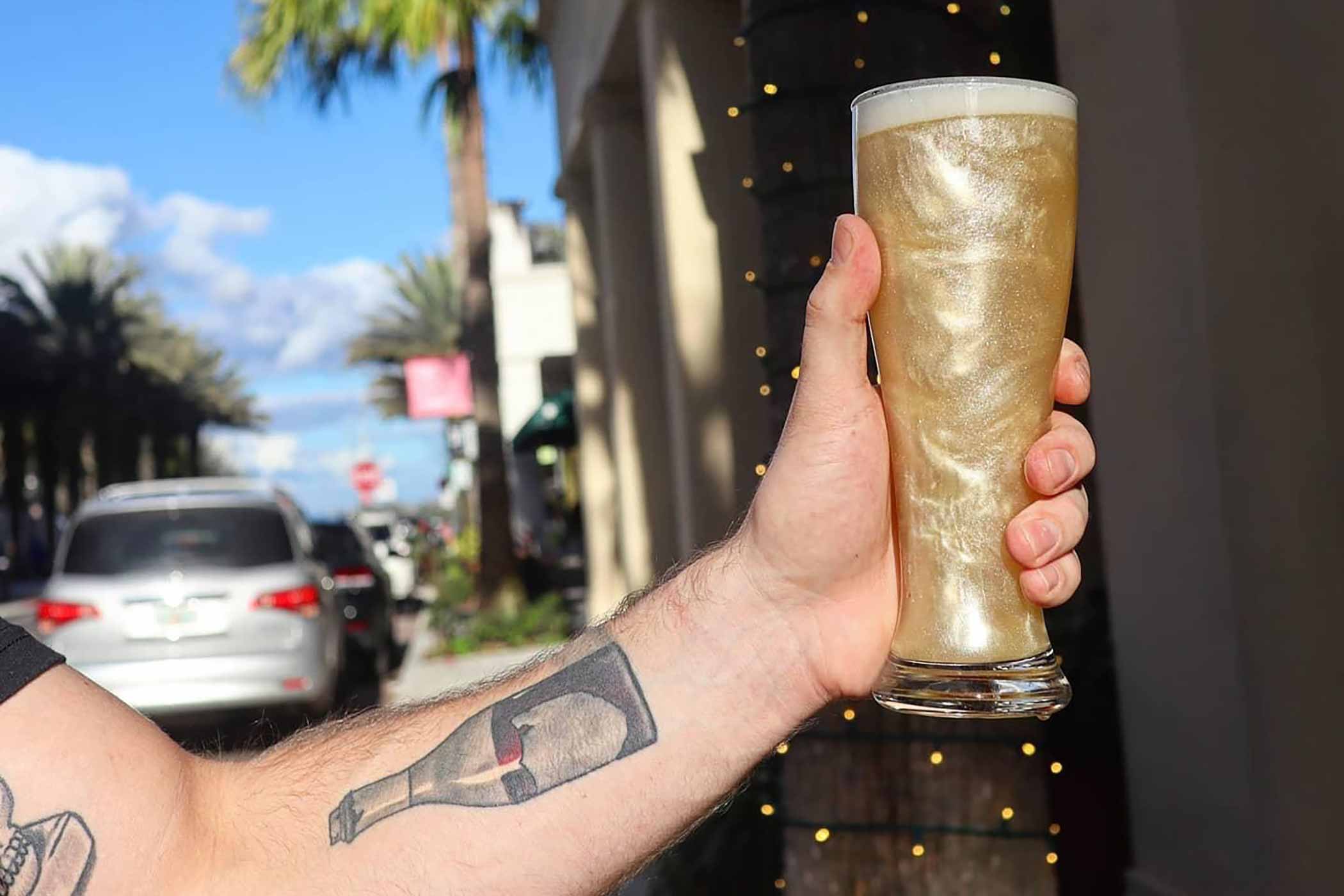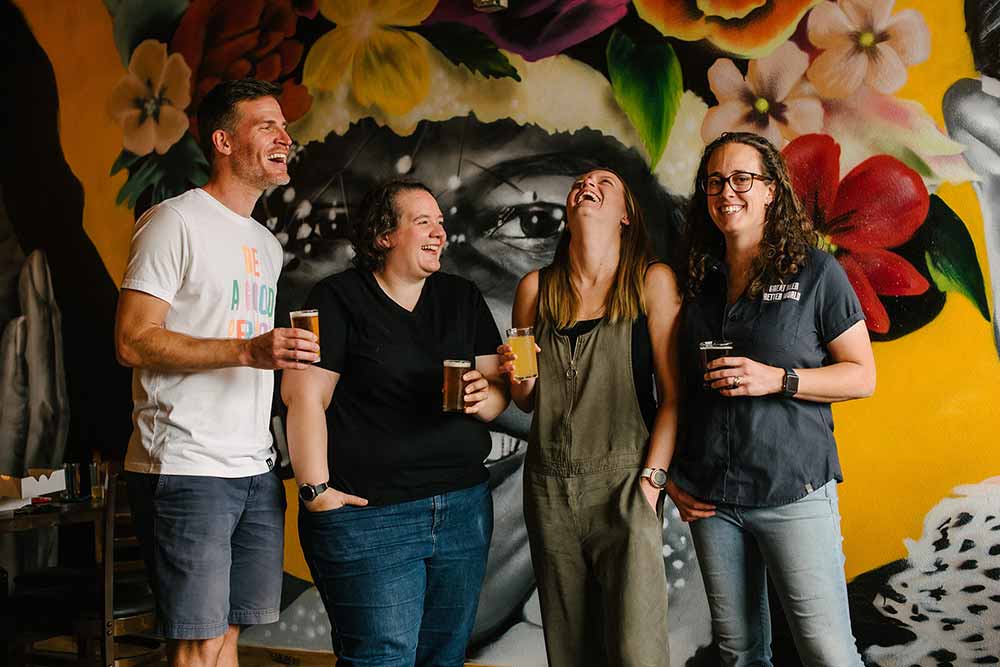Shop
All That Glitters Will Be Gold Again: A Shimmering Glitter Beer Resurgence?
Not just a mirage.
Hop Culture's Top Stories:
Swirling, translucent, shimmering, the glass almost seemed to vibrate, like a wormhole to another universe. Look long enough within its sparkling depths, and you might lose yourself for a second, sucked back in time to the glittery artwork you proudly brought home for your parents to display with a vacation magnet on the fridge. As an adult, however, you never would have guessed the twinkling thing you were about to bring to your lips was a beer. Around 2018, the iridescent glitter beer became a cultural hit on par with fidget spinners and Amazon Echo Dots.
Although a short-lived trend, glitter beers have cropped back up within the last few years.
Often found around Pride or other holidays such as New Year’s Eve, glitter beers have become more than just a fun gimmick; they’re a form of expression and defiance of the gendered norms of craft beer.
We just got real with glitter real quick. And here’s why.
The Mirage of Glitter Beer: A Short, Shimmering History
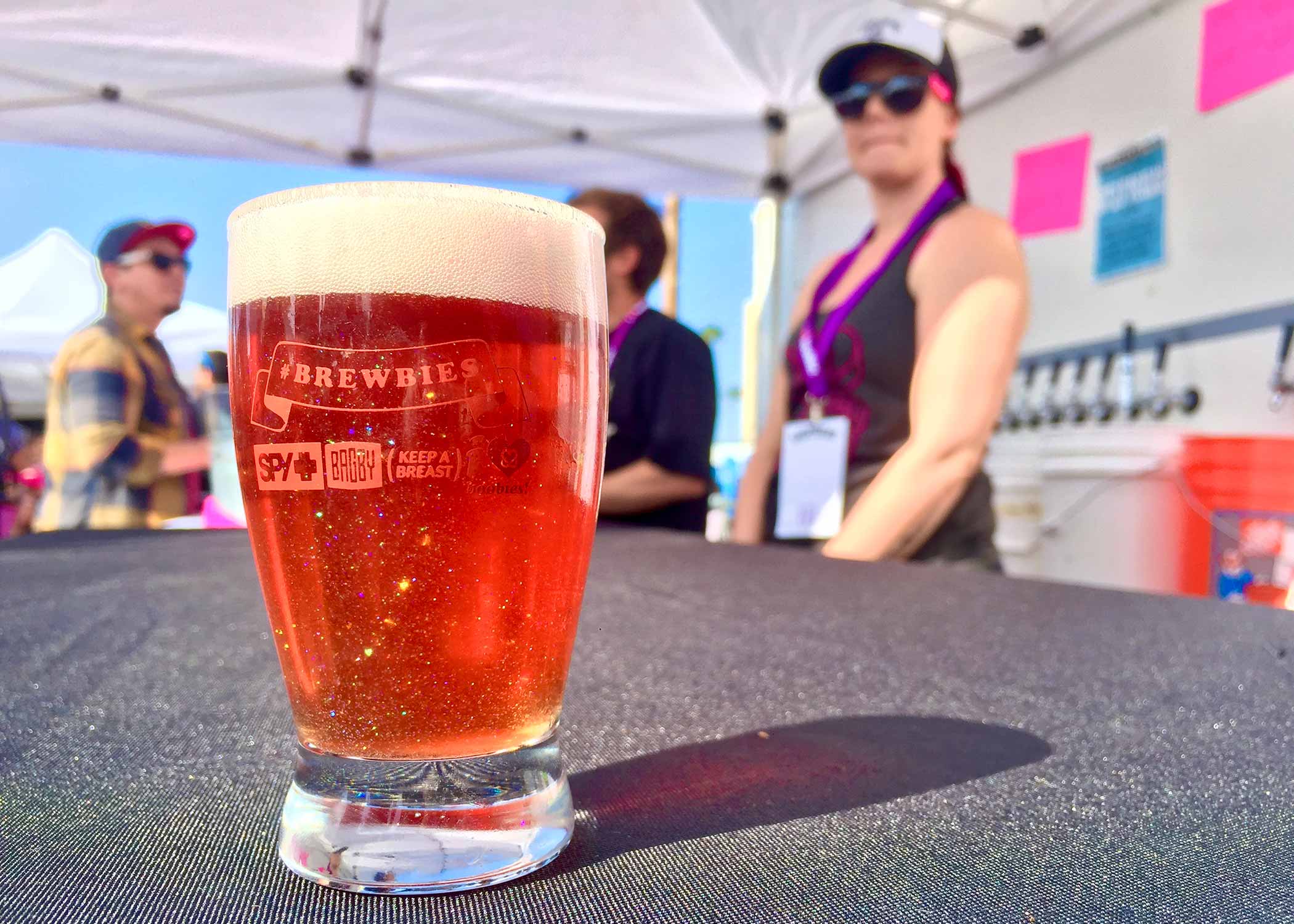
Photography courtesy of Alexandra Nowell, former Three Weavers Brewing Company Director of Operations
When looking for the exact origin of glitter beer, we can’t point to one specific point in time. Most folks we talked to reference Alexandra Nowell, the former director of operations at Three Weavers Brewing Company and current co-founder of Mellotone Beer Project. But Nowell says she wasn’t the first, pointing to Wynkoop and a pastry as two of her own inspirations.
“I think I was eating a pastry that had edible glitter on it … and I was like, has this been done before [in beer]?” recounts the self-proclaimed glitter lover.
She promptly bought six different types of glitter with varying thicknesses, colors, and shimmers, trying them out in beer recipes.
Maybe Nowell wasn’t the first, but many cite her first glitter beer—Mel’s Sparkle Pony—as sparking the trend.
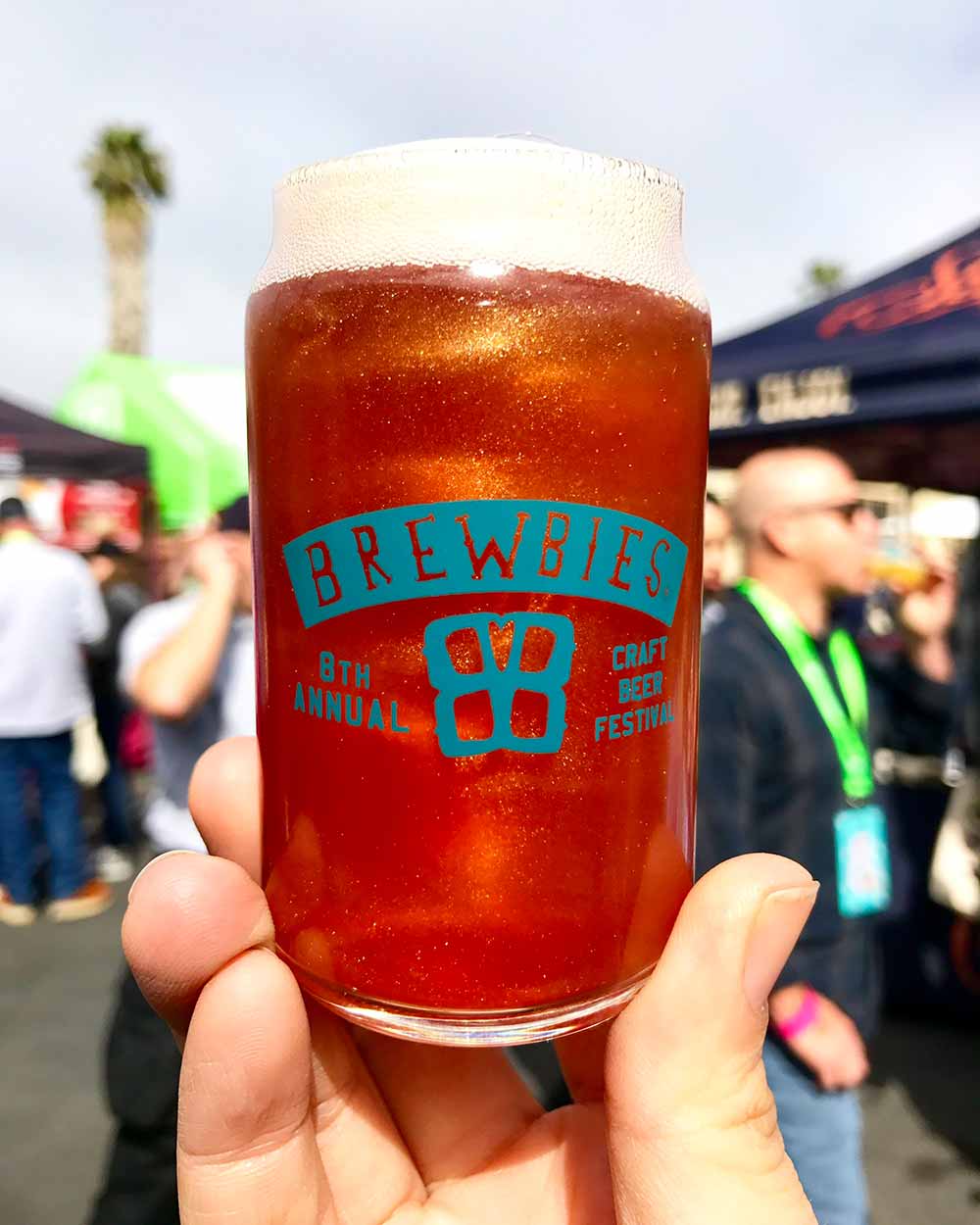
Photography courtesy of Alexandra Nowell, former Three Weavers Brewing Company Director of Operations
Made for an event called Brewbies, a beer festival in California to raise money for breast cancer awareness, Mel’s Sparkle Pony was a part of the fest’s pink beer competition.
The pink IPA, a nod to Nowell’s friend and Brewbies Founder, Melanie Pierce, included hibiscus, for color, and glitter because “Mel is fabulous!” says Nowell.
The beer crushed. Something about holding that taster full of ruby-colored iridescence shimmering in the festival sun wowed folks.
Those like former Seabright Brewer and current Yakima Chief Hops Copywriting Manager Cat Wiest, who volunteered at Brewbies, pouring samples of Mel’s Sparkle Pony.
“I passed it over to people and watched their enthusiasm, then I just lost my mind,” recalls Wiest, who has a soft spot for shimmery things, often painting her nails with sparkly polish and confessing she has a wall in her office painted with a hazy/ethereal lavender/blue glitter paint. “I love glitter and everything sparkly. When I saw this sparkly beer and the way people responded to it, I was incredibly excited.”
After the event, Wiest reached out to Nowell to ask if she would spill the secrets. Nowell immediately shared the name of her glitter supplier. “Hell, yes!” Wiest thought. “Let us make the world a more sparkly place.”
Like glitter spilled on the floor, the trend started to spread.
Glitter Flash in the Can
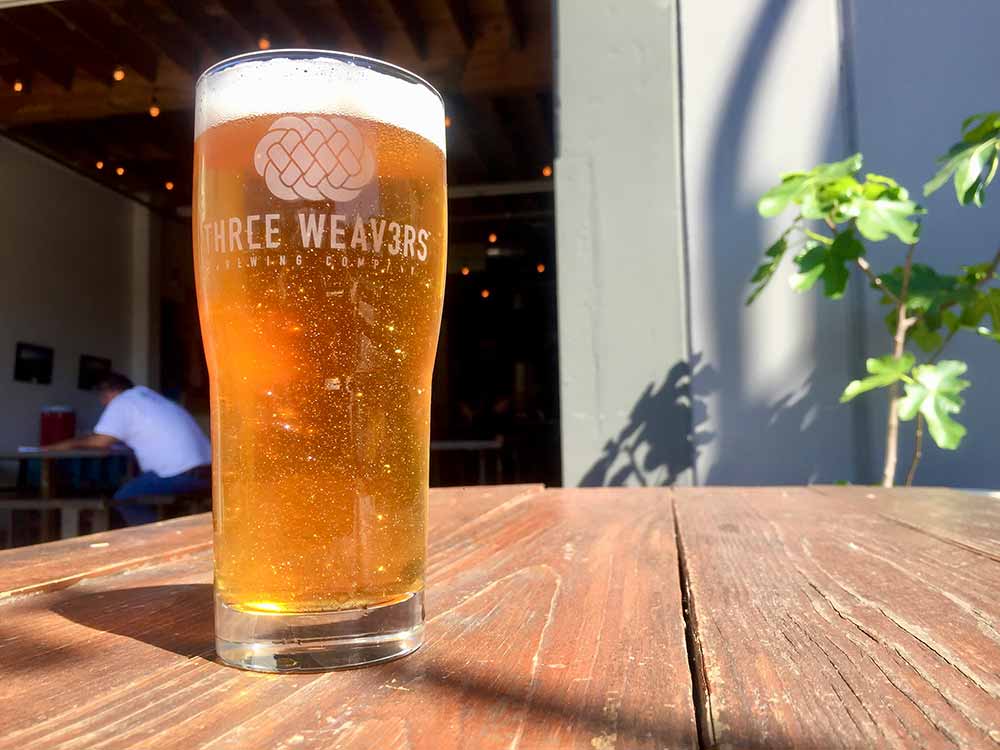
Photography courtesy of Alexandra Nowell, former Three Weavers Brewing Company Director of Operations
Actually, it’s incredibly hard to can glitter for all the reasons that you imagine when handing a three-year-old a canister of glitter; it gets everywhere, sticking in filling lines and tanks.
But that didn’t stop Wiest from trying.
Back at Seabright Brewery in Santa Cruz, she brewed her own glitter beer—Mermaid Tail Ale, sending packaged versions to the Great American Beer Festival for judging.
“I wanted glitter beer to be a thing!” she says.
Although Wiest admits, this was challenging.
First of all, glitter beer really worked best on draft and at festivals where people could hold the glass up to the light or sun and give it a swirl. “Everybody got excited,” Wiest says. “It was usually gasps of excitement and squeals of glee; everybody wanted to take a photo.”
Getting that glitter into suspension was key. Everyone I talked to mentioned that for the best effect, glitter beer kegs should be stored upside down until serving. Imagine a snow globe; to get the effect of flakes falling and dispersing, you need to turn the orb upside down. It’s similar with glitter beer, making the theatrical effect hard to replicate in a can.
At Seabright, Wiest’s Mermaid’s Tail Ale included beets and blood orange for that lovely pinkish hue. Once Wiest carbed the beer, she would inject a mix of Ultraviolet Pearl, Red Pearl, and Ultra Silver Sparkle glitter either in the brite tanks or during kegging, where a sixtel got hit with two to three grams.
“The Sparkle captured and reflected the brightest light, and the Pearl had this nice meandering veil of shimmer,” she remembers.
A little went a long way. Wiest paid two to three dollars for a small two-gram container, so it would cost about five to six dollars to “sparkle up a six-barrel,” she says.
And Wiest certainly wasn’t the only one glittering up beer.
Today, if you Google glitter beer, you’ll find a slew of articles covering the craze, citing dozens of different beers.
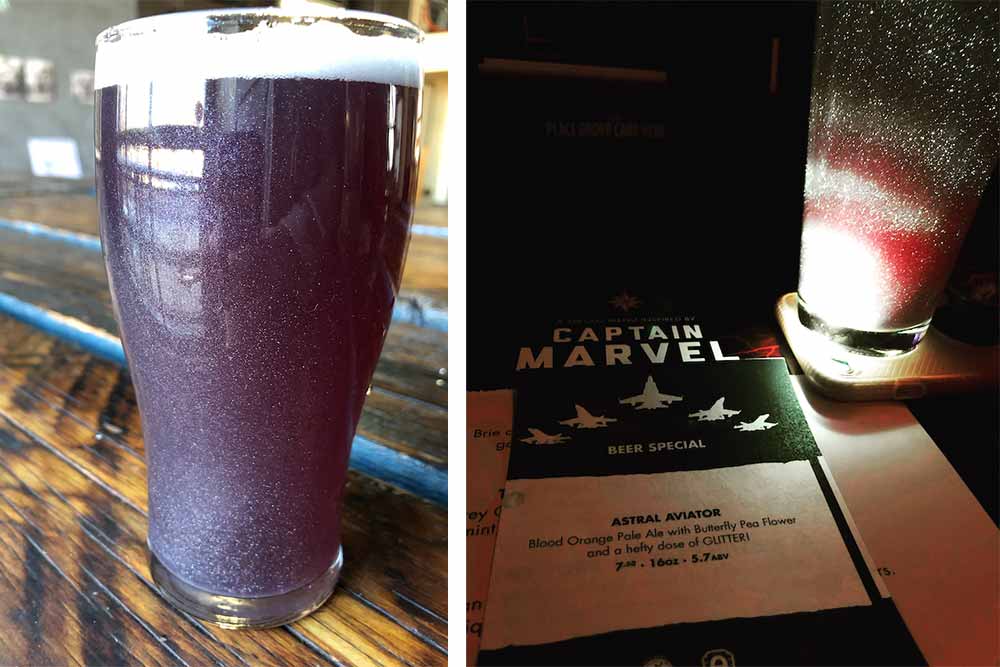
Photography courtesy of Lady Justice Brewing
At Lady Justice Brewing Company in Colorado, co-founder Betsy Lay says they brewed their first glitter beer in 2018. A collaboration with Alamo Drafthouse to celebrate the release of the Captain Marvel movie Astral Aviator included butterfly pea powder (that turns your beer purple) and edible food-safe glitter.
“We thought glitter would help make the beer a galactic-space-Captain-Marvel-fighting-crime-in-the-universe deal,” recalls Lay, noting people went crazy.
They followed that up with two more glitter beers, both for festivals, Glitterita and Gold Rush.
“It was really fun to watch people get a beer, hold it up to the light, smile, laugh, and enjoy getting something that felt almost kid-like,” says Lay. “Glitter is not something adults hang out with much, so it was fun to watch adults laugh and smile at beer in a kid-like wonder.”
After the initial surprise of Mel’s Sparkle Pony at the Brewbies festival, Nowell says people started to demand the beer. Although first thinking she would only brew the gimmick for a good cause, Nowell caved and made another glitter beer for St. Patrick’s Day—Expatriate—a pot of gold full of gold glitter.
“That keg always went so fast,” she recounts. “Every year, we would make another keg and the next year another.”
People went gaga for this new glitter galaxy because it added a visual element to drinking akin to a whimsically decorated cupcake or sprinkle donut.
With beer, Nowell says if the sun hits your glass just the right way, spotlighting the swirling luminesce inside, it could make you pause and ask, “Is there a universe in my glass!?”
But not everyone wanted to live in this sparkling universe.
The Glitzy Truth: Glitter Beer’s Polar Opposites
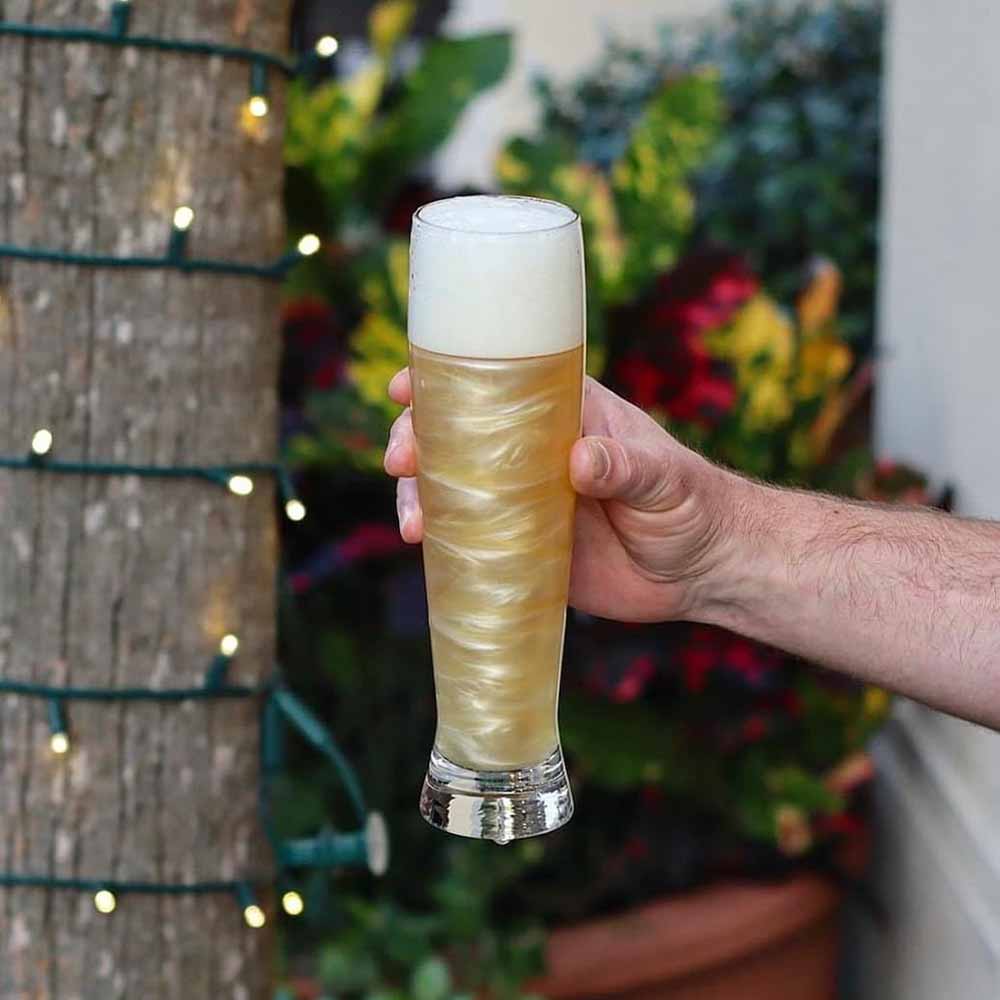
Photography courtesy of Tactical Brewing
Much like pumpkin beer or glass vs. can, the glitter fever incited controversy—enthusiasm from some and rage from others.
Purists felt that glitter had no place in beer.
“Sometimes people take beer a little too seriously,” says Nowell. “This is my career, my vocation, and my passion. I do take it very seriously, but at the end of the day, it’s beer. … Glitter allows the beer to remain playful while still delicious.”
Nowell points out that the edible FDA-approved glitter doesn’t actually alter taste at all, simply appearance.
When I asked the question of why glitter beer is so polarizing, “If I weren’t wearing sunglasses, you would have seen me roll my eyes,” Nowell laughs wryly. “Serious beer connoisseurs think you’re ruining something so sacred. Beer is very sacred to me; it’s how I make my living. … So, yes, I consider it fairly sacred, but it still needs to be fun.”
Tactical Brewing Owner Doug Meyer, who adds glitter to the brewery’s American lager every year for the brewery’s New Year’s Eve party, admits that this trend didn’t last because “some breweries I know don’t want to tread on making some of the more traditional guys upset with them,” he says. “You don’t want your triple-decocted Czech pils to have glitter in it.”
But Meyer says Tactical likes to balance fun with a more traditional portfolio, so they really enjoy dosing a beer with glitter for one night out of the year.
As long as the beer still tastes as intended, why not create something fun and whimsical?
How is it any different from a Mai Tai that comes in a tiki-inspired glass or a flaming Dr. Pepper shot?
“Two things can be true: How about it’s a super great beer, and it gets people excited with a multi-dimensional sensory experience?” says Wiest.
When getting down to brass tacks, Wiest’s answer widens the schism even further. Even something as fun as glitter has prejudice.
The Glitzy Truth: Glitter Beer’s Gendered Stereotypes
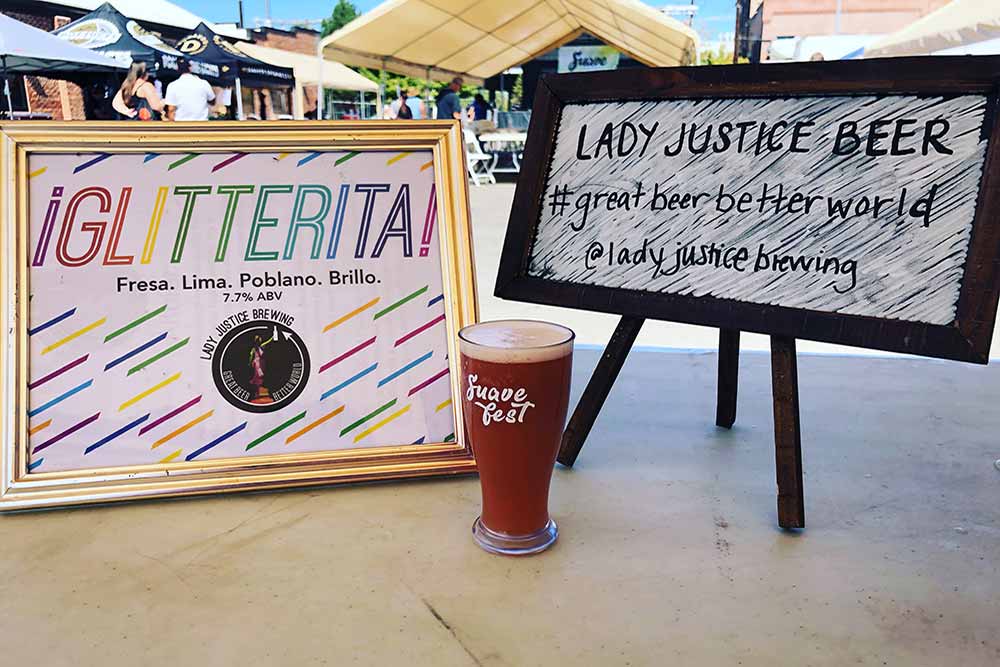
Photography courtesy of Lady Justice Brewing
“I got a lot of comments like glitter is for strippers, so is this a stripper beer?” Wiest says. “That’s offensive to strippers; it’s offensive to glitter; it’s offensive to everybody. Strippers are rad, so that type of language to embody a ‘less-than’ perspective, I found pretty offensive.”
It’s crazy how something so seemingly simple to a kid became complex, mired in gendered stereotypes as an adult. In modern society, glitter is associated with stripping, femininity, and, frequently, Queerness.
For that reason, both Wiest and Nowell believe, glitter beer never truly caught fire, lasting only a few years.
“There were so many dudes running breweries who were like, why are you putting glitter in your beer?” says Nowell.
In 2018, the demographic of craft drinkers split between 31.5% female and 68.5% male, according to the Brewers Association reviewing numbers from Nielsen Harris on Demand.
“I didn’t see a lot of quote-unquote stereotypical beer drinkers in 2018-2019 stoked about drinking something sparkly and pretty,” explains Lay, who believes it was a problem with mainstream beer culture.
“I hesitate to call it feminine, but this [is a] resistance to being fabulous and sparkly,” she says, noting it’s no surprise those last two adjectives often blatantly blanket the Queer community. “I can see very easily how straight dudes in beer might feel uncomfortable. … Mainstream beer culture doesn’t want to embrace something read as feminine or gay.”
Wiest doubles down. “I have unapologetically said this before. … The beer industry is sexist,” Wiest says. “[Glitter beer] didn’t grab on because it was considered ‘girly’ or for strippers.’
Still, almost six years after the first glitter beer sprung into the spotlight, there is cause for optimism.
For those who still make the lustrous liquid, glitter beer has become a glowing symbol. One that says it’s okay to be your fabulous, glittery self.
As Nowell notes, “I think it remains something special.”
Be Your Fabulous, Glittery Self
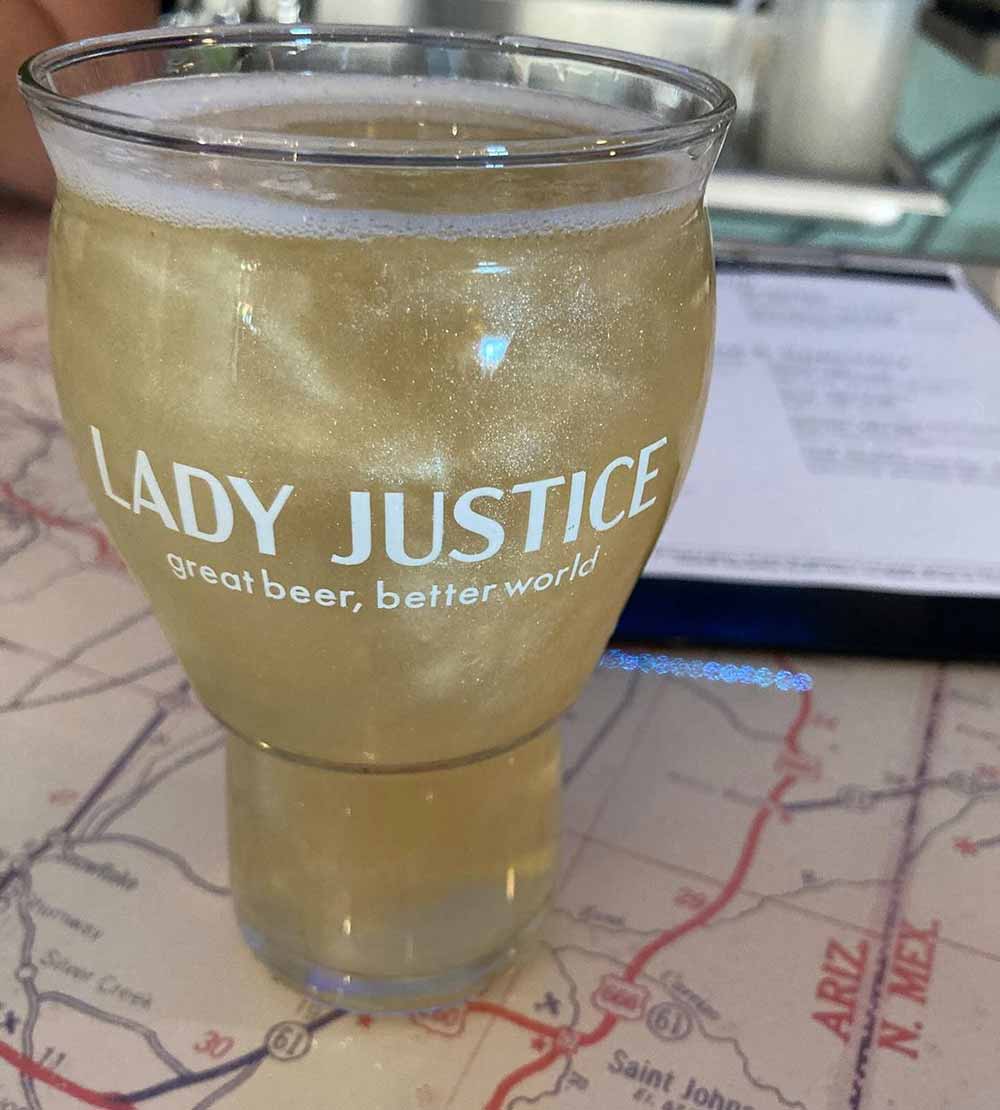
Photography courtesy of Lady Justice Brewing
At Lady Justice, you can add glitter—a crushed pearl luster—to your beer any time of the year. It’s called “Making Your Beer Fabulous.” Just pay an extra dollar, and the bartender will glitz up any ale or lager you want, giving it this iridescent shimmery color.
The tradition started around Pride month in June but has become an everyday statement at the Queer-owned brewery.
“It feels silly to say that being able to choose to add glitter to your beer is empowering, but there is something about being able to be in a craft beer space … and add glitter to your beer to be more sparkly than you already are,” says Lay. “You can make things fabulous whenever you want.”
Lay says the year-round glitter offering just makes people happy and brings a lot of joy. And isn’t that what glitter is all about anyway?
At least for the Queer community, glitter has become a way of reclaiming identity, taking something seen by straight masculine culture as “other” and flinging it back in their face as a form of true expression.
Which is probably why you’re seeing glitter beers at more and more Queer-owned businesses.
Five years ago, with the trend in full swing, glitter beer wasn’t even a twinkle in the eyes of Queer-owned Bow & Arrow Brewing Company Co-Founders Shyla Sheppard and Missy Begay.
Today, they brew one every Pride month.
“We want people to shine and be their most authentic selves,” says Sheppard. “Glitter embodies that—shiny, sparkly, and fun.”
In 2021, Bow & Arrow dropped its first glitter beer, posting a viral IG Reel. “The glitter beer was sparkling and swirling in the sun, and people went bananas over it,” laughs Sheppard.
Each June, Bow & Arrow has kept the tradition alive. This year, they brewed You Must Be My Lucky Star, a collab with Omega Yeast featuring a new thiolized yeast strain called Star Party.
Over the years, Sheppard says they’ve experimented with all types of glitter—purple, pink, yellow—but have decided pink works best.
Overwhelmingly, Sheppard says the response has been positive. “People are excited,” she says. “It’s fun, and I think beer should be fun.” And since they only release the glitter beer in limited quantities, people seek it out every year.
“We’re already really unique in the industry and the space as Native women, and we’re a married couple, so I feel like our customers embrace and are open to these things by nature,” says Sheppard. “I imagine it could be very different [in] a more traditional brewery with [a different] customer base.”
At Tactical Brewing, Meyer says glitter, too, once gave him pause. “But at the end of the day, we’re here to make beer, and we’re here to have fun with it.”
A few years ago, the brewery decided to make a glitter beer for a New Year’s Eve party they host annually. “It just seemed like a bright, gold, glitter liquid that you could drink was perfect for the occasion,” Meyer recounts, admitting that friends in the industry shook their heads at him. “But they laughed, came over, and drank some,” he says. “And once you see it, it’s like, okay, this is actually really cool.”
Overall, Meyer says Tactical’s customers seem to really enjoy the beer, which turns out “almost like a disco ball.”
Tactical doses its unfiltered American light lager with edible glitter from one of its brewing suppliers.
“It just makes it bright gold, almost as if you have on a sequin dress,” Meyer shares. “If it’s moving, it does a tornado effect inside that glass, which looks really cool!”
That first year, Tactical glittered two to three kegs, and “it sold out before midnight,” exclaims Meyers.
Unapologetically, the brewery has no plans to stop this tradition in the future.
Complexity and Chaos From Mundane Objects
As we wrapped up our conversation, Wiest ruminated on a book she had recently read called Glitter: Object Lessons , part of a series focusing on the importance of mundane objects. While writing, author Nicole Seymour reached out to Wiest because she wanted to include a section on glitter beer.
Before our chat, Wiest said she had re-read a quote on the inside cover.
Glitter reveals the complexity of an object often dismissed as frivolous.
“I like that dichotomy between complex and frivolous,” she says, admitting she hadn’t quite fully unpacked what those words meant to her, but she planned to write it on a notecard and stick it on her wall as a reminder. “We’re all complex people. Historically, beer is a very complex beverage. … [And] glitter, it turns out, can be an incredibly polarizing and complex issue.”
Who would have thought, right?
Today, we’ll say that glitter beer hasn’t entirely lost its luster; it’s just giving off a different gleam.
And it seems like these days, we could all use a little more glitter…beer in our lives.

